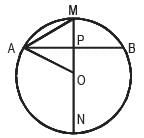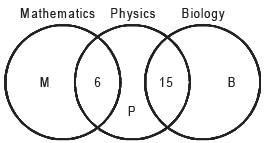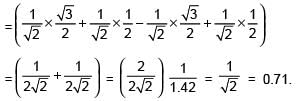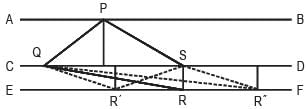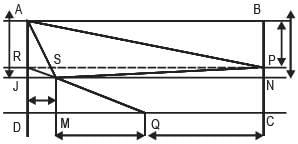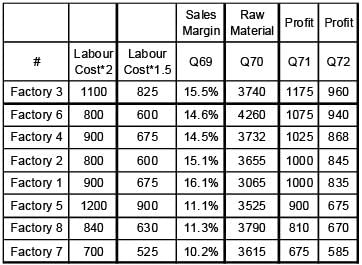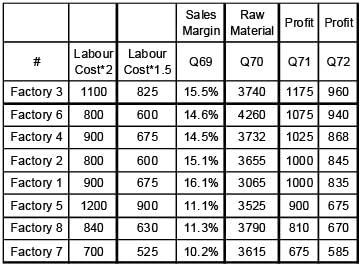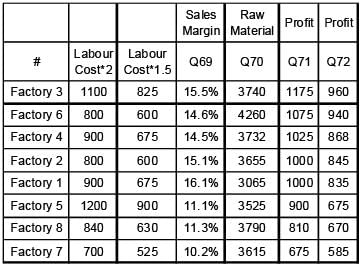Test: XAT Quant 2017 - CAT MCQ
27 Questions MCQ Test - Test: XAT Quant 2017
The sum of series, (–100) + (–95) + (–90) + .............. + 110 + 115 + 120, is:
Four two-way pipes A, B, C and D can either fill an empty tank or drain the full tank in 4, 10, 12 and 20 minutes respectively. All four pipes were opened simultaneously when the tank is empty.
Q. Under which of the following conditions the tank would be half filled after 30 minutes?
A shop, which sold same marked price shirts, announced an offer - if one buys three shirts then the fourth shirt is sold at a discounted price of ₹100 only. Patel took the offer. He left the shop with 20 shirts after paying ₹20,000.
Q. What is the marked price of a shirt?
AB is a chord of a circle. The length of AB is 24 cm. P is the midpoint of AB. Perpendiculars from P on either side of the chord meets the circle at M and N respectively. If, PM < PN and PM = 8 cm. then
Q. what will be the length of PN?
If x and y are real numbers, the least possible value of the expression 4(x – 2)2 + 4(y – 3)2 – 2(x – 3)2 is:
If f(x) = ax + b, a and b are positive real numbers and if f(x)) = 9x + 8, then the value of a + b is:
Arup and Swarup leave point A at 8 AM to point B. To reach B, they have to walk the first 2 km, then travel 4 km by boat and complete the final 20 km by car. Arup and Swarup walk at a constant speed of 4 km/hr and 5 km/hr respectively. Each rows his boat for 30 minutes. Arup drives his car at a constant speed of 50 km/hr while Swarup drives at 40 km/hr. If no time is wasted in transit, when will they meet again?
Hari's family consisted of his younger brother (Chari), younger sister (Gouri), and their father and mother. When Chari was born, the sum of the ages of Hari, his father and mother was 70 years. The sum of the ages of four family members, at the time of Gouri's birth, was twice the sum of ages of Hari's father and mother at the time of Hari's birth. If Chari is 4 years older than Gouri, then find the difference in age between Hari and Chari.
In a True/False quiz, 4 marks are awarded for each correct answer and 1 mark is deducted for each wrong answer. Amit, Benn and Chitra answered the same 10 questions, and their answers are given below in the same sequential order.

Q. If Amit and Benn both score 35 marks each then Chitra's score will be:
In a class of 60, along with English as a common subject, students can opt to major in Mathematics, Physics, Biology or a combination of any two. 6 students major in both Mathematics and Physics, 15 major in both Physics and Biology, but no one majors in both Mathematics and Biology. In an English test, the average mark scored by students majoring in Mathematics is 45 and that of students majoring in Biology is 60. However, the combined average mark in English, of students of these two majors, is 50.
Q. What is the maximum possible number of students who major ONLY in Physics?
If 5°≤x°≤ 15°, then the value of sin 30° + cos x° – sin x° will be:
The volume of a pyramid with a square base is 200 cm3. The height of the pyramid is 13 cm. What will be the length of the slant edges (i.e., the distance between the apex and any other vertex), rounded to the nearest integer?
A dice is rolled twice. What is the probability that the number in the second roll will be higher than that in the first?
An institute has 5 departments and each department has 50 students. If students are picked up randomly from all 5 departments to, form a committee, what should be the minimum number of students in the committee so that atleast one department should have representation of minimum 5 students?
If N = (11p+7)(7q–2)(5r+1)(35) is a perfect cube, where p, q, r and s are positive integers, then the smallest value of p + q + r + s is:
AB, CD and EF are three parallel lines, in that order. Let d1 and d2 be the distances from CD to AB and EF respectively. d1 and d2 are integers, where d1 : d2 = 2 : 1. P is a point on AB, Q and S are points on CD and R is a point on EF. If the area of the quadrilateral PQRS is 30 square units,
Q. what is the value of QR when value of SR is the least?
ABCD is a rectangle. P, Q and R are the midpoint of BC, CD and DA. The point S lies on the line QR in such a way that SR : QS = 1 : 3. The ratio of the triangle APS and rectangle ABCD is
Study the data given in the caselet below and answer the questions that follow:
In an innings of a T20 cricket match (a team can bowl for 20 avers) 6 bowlers bowled from the fielding side, with a bowler allowed maximum of 4 overs. Only the three specialist bowlers bowled their full quota of 4 overs each, and the remaining 8 overs were shared among three non-specialist bowlers. The economy rates of four bowlers were6, 6, 7 and 9 respectively. (Economy rate is the total number of runs conceded by a bowler divided by the number of overs bowled by that bowler). This however, does not include the data of the best bowler (lowest economy rate) and the worst bowler (highest economy rate). The number of overs bowled and the economy rate of any bowler are in integers.
Read the two statements below: S1: The worst bowler did not bowl the minimum number of overs. S2: The best bowler is a specialist bowler.
Q. Which of the above statements or their combinations can help arrive at the minimum number of overs bowled by a non-specialist bowler?
Study the data given in the caselet below and answer the questions that follow:
In an innings of a T20 cricket match (a team can bowl for 20 avers) 6 bowlers bowled from the fielding side, with a bowler allowed maximum of 4 overs. Only the three specialist bowlers bowled their full quota of 4 overs each, and the remaining 8 overs were shared among three non-specialist bowlers. The economy rates of four bowlers were6, 6, 7 and 9 respectively. (Economy rate is the total number of runs conceded by a bowler divided by the number of overs bowled by that bowler). This however, does not include the data of the best bowler (lowest economy rate) and the worst bowler (highest economy rate). The number of overs bowled and the economy rate of any bowler are in integers.
Read the two statements below: S1: The worst bowler did not bowl the minimum number of overs. S2: The best bowler is a specialist bowler.
Read the two statements below: S1. The economy rates of the specialist bowlers are lower than that of the non-specialist bowlers. S2. The cumulative runs conceded by the three non-specialist bowlers were 1 more than those conceded by the three specialist bowlers.
Q. Which of the above statements or their combinations can help arrive at the economy rate of the worst bowler?
Study the paragraph below and answer the questions that follow:
Abdul has 8 factories, with different capacities, producing boutique kurtas. In the production process, he incurs raw material, cost, selling cost (for packaging and transportation) and labour cost. These costs per kurta vary across factories. In all these factories, a worker takes 2 hours to produce a kurta. Profit per kurta is calculated by deducting raw material cost, selling cost and labour cost from the selling price (Profit = selling price – raw materials cost – selling cost – labour cost). Any other cost can be ignored.
Exhibit: Business Details of Abdul's 8 Factories
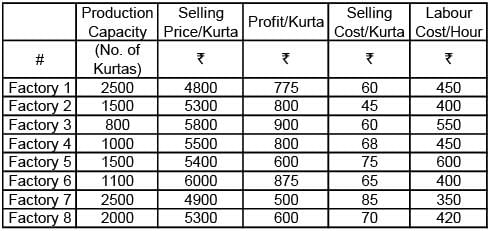
Q. Which of the following options is in decreasing order of raw materials cost?
Study the paragraph below and answer the questions that follow:
Abdul has 8 factories, with different capacities, producing boutique kurtas. In the production process, he incurs raw material, cost, selling cost (for packaging and transportation) and labour cost. These costs per kurta vary across factories. In all these factories, a worker takes 2 hours to produce a kurta. Profit per kurta is calculated by deducting raw material cost, selling cost and labour cost from the selling price (Profit = selling price – raw materials cost – selling cost – labour cost). Any other cost can be ignored.
Exhibit: Business Details of Abdul's 8 Factories
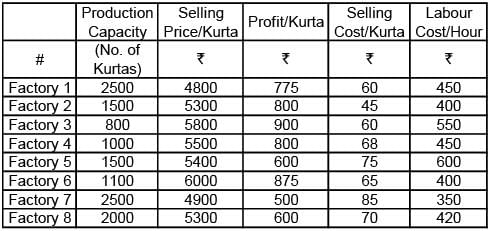
Q. Which of the factories listed in the options below has the lowest sales margin (sales margin = profit per kurta divided by selling price per kurta)?
Study the paragraph below and answer the questions that follow:
Abdul has 8 factories, with different capacities, producing boutique kurtas. In the production process, he incurs raw material, cost, selling cost (for packaging and transportation) and labour cost. These costs per kurta vary across factories. In all these factories, a worker takes 2 hours to produce a kurta. Profit per kurta is calculated by deducting raw material cost, selling cost and labour cost from the selling price (Profit = selling price – raw materials cost – selling cost – labour cost). Any other cost can be ignored.
Exhibit: Business Details of Abdul's 8 Factories
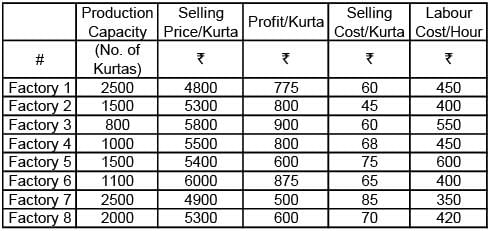
Abdul has received an order for 2,000 kurtas from a big retail chain. They will collect the finished pre-packaged kurtas directly from the factories, saving him the selling cost. To deliver this order, he can use multiple factories for production.
Q. Which of the following options will ensure maximum profit from this order?
Study the paragraph below and answer the questions that follow:
Abdul has 8 factories, with different capacities, producing boutique kurtas. In the production process, he incurs raw material, cost, selling cost (for packaging and transportation) and labour cost. These costs per kurta vary across factories. In all these factories, a worker takes 2 hours to produce a kurta. Profit per kurta is calculated by deducting raw material cost, selling cost and labour cost from the selling price (Profit = selling price – raw materials cost – selling cost – labour cost). Any other cost can be ignored.
Exhibit: Business Details of Abdul's 8 Factories
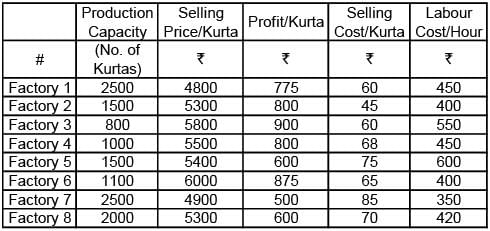
Abdul has introduced a new technology in all his factories. As a result, a worker needs just 1.5 hours to produce a kurta. If raw materials cost and selling cost remain the same,
Q. which of the factories listed in the options below will yield the highest profit per kurta?
Analyse the graph below and answer the questions that follow:
The grid below captures relationships among seven personality dimensions: "extraversion", "true_arousal_plac", "true_arousal_caff', "arousal_plac", "arousal_caff', "performance_plac", and "performance_caff'. The diagonal represents histograms of the seven dimensions. Left of the diagonal represents scatterplots between the dimensions while the right of the diagonal represents quantitative relationships between the dimensions. The lines in the scatterplots are closest approximation of the points. The value of the relationships to the right of the diagonal can vary from –1 to +1, with –1 being the extreme linear negative relation and +1 extreme linear positive relation. (Axes of the graph are conventionally drawn).
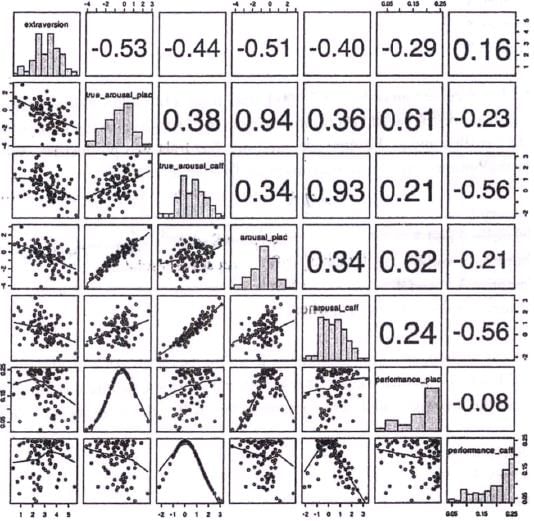
Q. Which of the following is true?
Analyse the graph below and answer the questions that follow:
The grid below captures relationships among seven personality dimensions: "extraversion", "true_arousal_plac", "true_arousal_caff', "arousal_plac", "arousal_caff', "performance_plac", and "performance_caff'. The diagonal represents histograms of the seven dimensions. Left of the diagonal represents scatterplots between the dimensions while the right of the diagonal represents quantitative relationships between the dimensions. The lines in the scatterplots are closest approximation of the points. The value of the relationships to the right of the diagonal can vary from –1 to +1, with –1 being the extreme linear negative relation and +1 extreme linear positive relation. (Axes of the graph are conventionally drawn).
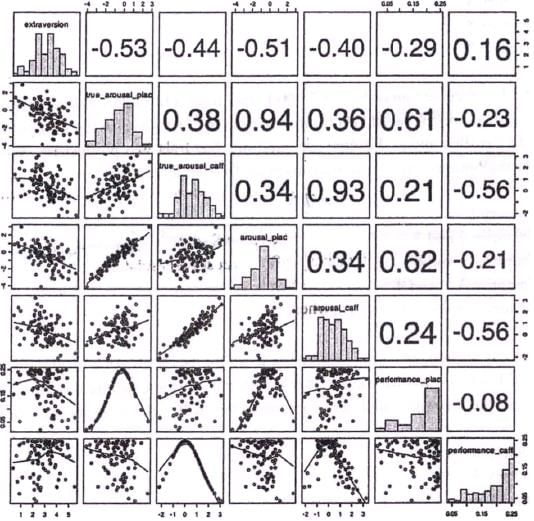
Q. Which of the scatterplots shows the weakest relationship?
Analyse the graph below and answer the questions that follow:
The grid below captures relationships among seven personality dimensions: "extraversion", "true_arousal_plac", "true_arousal_caff', "arousal_plac", "arousal_caff', "performance_plac", and "performance_caff'. The diagonal represents histograms of the seven dimensions. Left of the diagonal represents scatterplots between the dimensions while the right of the diagonal represents quantitative relationships between the dimensions. The lines in the scatterplots are closest approximation of the points. The value of the relationships to the right of the diagonal can vary from –1 to +1, with –1 being the extreme linear negative relation and +1 extreme linear positive relation. (Axes of the graph are conventionally drawn).
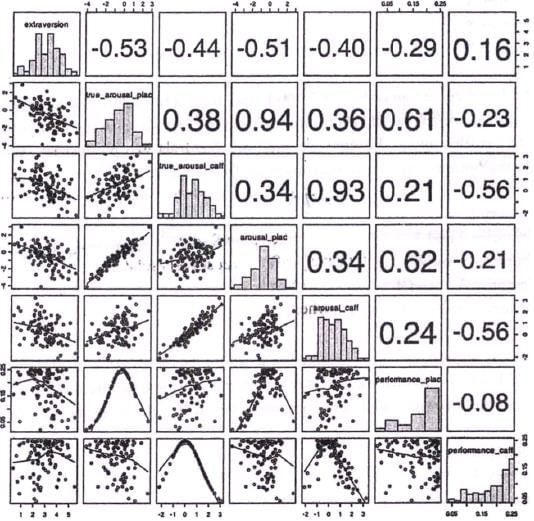
Q. In which of the following scatterplots, the value of one dimension can be used to predict the value of another, as accurately as possible?
Analyse the graph below and answer the questions that follow:
The grid below captures relationships among seven personality dimensions: "extraversion", "true_arousal_plac", "true_arousal_caff', "arousal_plac", "arousal_caff', "performance_plac", and "performance_caff'. The diagonal represents histograms of the seven dimensions. Left of the diagonal represents scatterplots between the dimensions while the right of the diagonal represents quantitative relationships between the dimensions. The lines in the scatterplots are closest approximation of the points. The value of the relationships to the right of the diagonal can vary from –1 to +1, with –1 being the extreme linear negative relation and +1 extreme linear positive relation. (Axes of the graph are conventionally drawn).
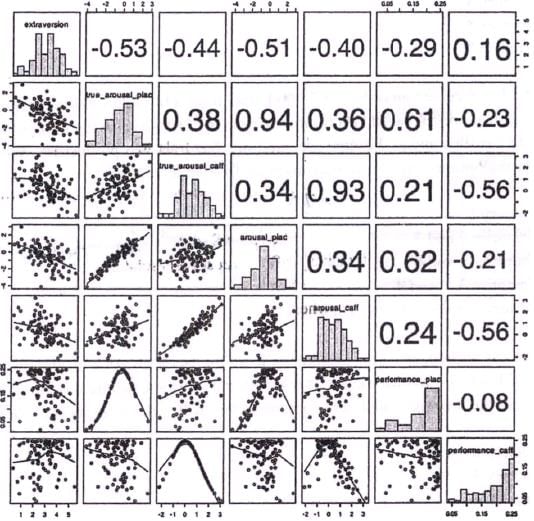
Q. Which of the following options is correct?



